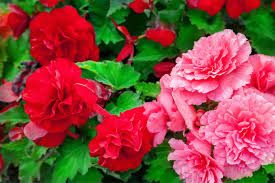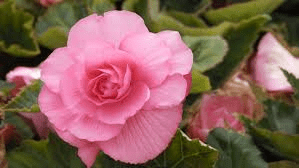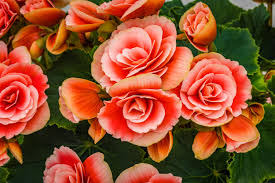Begonia Flowers are known for their attractive blooms, the Begonia is a timeless favorite among gardeners. it consists of more than 1,700 species. Begonias also make for good indoor plants if kept by a sunny window and watered regularly.
Its sun requirement is both a Full Sun or Partial Shade sun and a well-drained soil. They grow up to a Height of about: 0.5 – 1.5 feet and Blooms in: Late Spring – Early Fall with its Deer Resistant unique feature.
Common Begonia Flower Types
(1) Wax begonias
The most common are Begonia semperflorens varieties, also called wax, annual, or bedding begonias. These shade-loving plants bring mounds of color when planted under trees or tucked in planters, hanging baskets, or window boxes. Wax begonias are typically grown as annuals, reaching 6 to 12 inches tall and wide.
(2) Tuberous begonias
Another popular type, tuberous begonias have spectacular colorful flowers, and are particularly showy in hanging baskets or containers. They also have a larger growth habit than wax begonias, growing 12 to 18 inches tall as houseplants and up to 3 feet or more in outdoor containers.
(3) Cane begonias
With an upright growth habit and segmented stems, cane types have beautiful foliage and bloom in a wide array of colors. Angel wing begonias, named for their wing-shaped leaves, also belong to this group.
They are popular and well-suited as houseplants, but can also be grown outside. Their size varies with growing conditions, from 6- to 12-inch houseplants to bushy plants up to 5 feet.
(4) Rhizomatous begonias
The largest class, rhizomatous begonias are distinguished by relatively thick stems, or rhizomes, that grow horizontally near the soil surface and sprout new roots and leaves.
They also have some of the most interesting leaves and stems and are often grown as houseplants. Sizes vary from just a few inches to large plants up to 3 feet tall and wide.
(5) Rex begonias
A subgroup of rhizomatous, Rex begonias (Begonia rex), are widely available, sold by florists and garden centers year-round, and generally reach 12 to 18 inches tall and wide.
Their distinct foliage makes them a popular houseplant, but they can be finicky. They’re wonderful in summer flower beds or containers, especially when combined with ferns and other semi-shade companions.
Read Also: Aubrieta Flowers – All you need to Know

Planting Guide

(1) When to plant
Transplant after all threat of frost has passed, as they are extremely frost tender and even temperatures below 50 degrees can cause damage.
(2) Where to plant
Select a location that gets partial shade or filtered sunlight; with morning sun and afternoon shade being the best, especially where it is exceptionally hot.
For sunnier locations, try a dark-leaved variety or one that specifies improved sun tolerance. Plant in a location where they will have good air circulation to prevent powdery mildew.
(3) How to plant
Plant wax begonia transplants 6 to 8 inches apart and others according to their mature size. Tubers can be started indoors by placing the tubers, hollow side up, 1 inch apart in a shallow tray with moist potting mix.
Place the tray in a dark room and water just enough to keep the potting mix moist, but not soggy. Tubers should sprout in about 4 weeks and be moved to an area with bright light once the sprouts are about an inch tall. Only plant outdoors when there is no longer a threat of frost.
Read Also: Angelonia Flowers – All you need to know

Begonia Care
Tuberous begonias will naturally die back each year. Start decreasing water in late summer to early fall and trim back foliage when it starts to yellow. Dig up the tubers at the first threat of frost.
Clean any remaining dirt from the tubers and dry them on newspaper in a sunny location for about a week. To prevent powdery mildew, lightly dust them with sulfur powder and store individually in paper bags or wrapped in newspaper.
Rhizomatous and wax types don’t die back and are usually pinched or lightly pruned each year to keep them healthy and encourage full, but compact growth. In warmer climates, this is best done in spring.
In cooler climates, you can do this in fall as a clean-up before bringing them inside for the winter. In addition to cutting them back, check for signs of pests or disease before moving them indoors.
Slowly acclimate them to their new inside location by first placing in a bright window and gradually decreasing the amount of light. This will to help prevent stress, which causes the leaves to drop.
Once warmer temperatures return, reverse the process and move them back outside. See below for information on growing as houseplants.
For all types, deadheading spent begonia flowers keeps plants clean and healthy, as well as promotes more blooms.
(1) Soil Requirement
All begonias like evenly moist, well-draining soil with some added organic matter.
(2) Amendments and fertilizer
For general growing purposes, apply a balanced water-soluble fertilizer once a month in the growing season. For plants grown strictly for their foliage, like angel wings, use a fertilizer that is higher in nitrogen.
(3) Watering
Regular watering is important for healthy plants. The soil should remain moist at all times, but not too wet, as this can cause rot. Water at the base of the plant to keep the foliage dry and prevent leaf spot and fungal diseases.
(4) Diseases and pests
Susceptible to powdery mildew, mealy bugs, mites, thrips, and whitefly. Stem rot and rhizome rot can be caused by overwatering and soggy soil.
(5) Deer
Begonias are deer resistant.
Read Also: Anemone Flowers – All you need to know
Growing Begonias as House Plants
Although there can be some challenges, many will do quite well indoors.
(1) Water and humidity
Probably the quickest way to kill a begonia is too much water. Let them dry out slightly between waterings. If they are kept cool, you may notice they can tolerate a longer time without water.
Give them a boost of humidity by setting the pots in a pebble tray (a low tray or saucer filled with pebbles and water, with the pot sitting on top of the pebbles and not directly in the water).
(2) Location
East-, west-, or south-facing windows are best. If any burning occurs when grown in a south-facing window, move the plant farther from the window. As an alternative, they grow well under grow lights. Place where dry air from heater vents won’t blow directly on them.
(3) Potting
Potted begonias prefer to be slightly root-bound rather than given too much room. Only repot when necessary, and preferably in spring before plants are moved outside and start actively growing.
Read Also: The Complete List of Indigenous Crops of Africa
Frequently Asked Questions
We will update this section soon.

